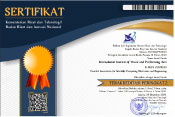(2) Hasbi Hasbi
*corresponding author
AbstractKacaping is a traditional musical instrument that holds significant cultural relevance in South Sulawesi, particularly among Bugis tribe. Its boat-like shape links its origins to skilled sailors who created it long ago. Kacaping continues to play a vital role in community events such as weddings, aqiqah, and government gatherings. In the educational context, kacaping is incorporated into local content curricula, showcasing traditional performances. Recently, the evolution of kacaping into a diatonic version known as kitoka has emerged. However, many young individuals recognize kacaping merely as an art form, often unaware of its historical significance and cultural lineage. This research aims to elucidate the role of kacaping as a traditional music product reflecting the maritime heritage of the Bugis community. Employing a descriptive qualitative approach, data were collected through observations, interviews, and documentation, subsequently analyzed and verified. Participants in this study included cultural figures, instrument makers, performers, and educators. The findings confirm that kacaping is deeply rooted in the seafaring culture of the Bugis, with its historical and functional evolution evident in written documents and the presence of similar boat-like instruments in households. This research underscores the importance of fostering an appreciation for kacaping among the youth, highlighting its ancestral values beyond mere artistic expression, and encouraging academic and cultural literacy in schools. KeywordsKacapi; Bugis; Sailor; South Sulawesi; Traditional
|
DOIhttps://doi.org/10.31763/viperarts.v6i2.1655 |
Article metrics10.31763/viperarts.v6i2.1655 Abstract views : 228 |
Cite |
References
[1] B. Sukarman, Kajian Desain Kecapi Sulawesi Selatan dan Kaitannya Dengan Budaya Maritim Masyarakatnya. Bandung: Program Megister Seni Rupa dan Desain, Fakultas Seni Rupa dan Desain, Institut Teknologi Bandung, 1999.
[2] A. W. Muslim, Budaya Maritim Bugis di Sulawesi Selatan. Makassar: Lembaga P, 2014. Makassar: Lembaga Penelitian Universitas Hasanuddin, 2014.
[3] M. Arif, Warisan Budaya Bugis: Analisis Aspek Musik dan Tari. Yogyakarta: Penerbit Andi, 2015.
[4] M. S. Sakdi, Musik Tradisional Indonesia. Malang: Malang University Press, 2018.
[5] Mustari, Kearifan Lokal dan Identitas Masyarakat Bugis. Makassar: Penerbit Universitas Hasanuddin, 2020.
[6] D. Handayani, Pengaruh Kacaping terhadap Identitas Budaya dalam Masyarakat Pelayaran, Tesis. Universitas Padjadjaran, 2019.
[7] A. Jamaluddin, “Kacaping dan Fungsi Sosialnya dalam Komunitas Bugis,†J. Sos. dan Budaya, vol. 6, no. 3, pp. 115–130, 2021.
[8] D. Asher, “Musik Bugis: Jembatan antara Tradisi dan Modernitas,†Proc. Annu. Cult. Stud. Conf., pp. 56–78, 2020.
[9] N. Fadli, “Kacaping dan Tradisi Maritim: Manifestasi Kearifan Lokal di Sulawesi Selatan,†Proc. Natl. Semin. Music Cult. Jakarta, Puslitbang, pp. 112–120, 2023.
[10] A. Zulfikar, “The Dynamics of Bugis Diaspora in the Development of Work Migration to Sabah Malaysia,†Diaspora Transnatl. Era Space, Area Netw., pp. 1–17, 2018.
[11] S. Syarifuddin and I. Hasyim, “Local Wisdom in South Sulawesi’s Folklores,†Int. J. Educ., vol. 2, 2022.
[12] S. Suhra, “Nilai-Nilai Pendidikan Islam dalam Permainan Tradisional Bugis Mappadendang,†Al-Ulum, vol. 20, no. 2, pp. 452–472, 2020, doi: 10.30603/au. v20i2.1742.
[13] K. Stenross, The Seafarers And Maritime Entrepreneurs Of Madura. 2007.
[14] R. Hampson, Review_of_Robert_Hampson_Conrads_Secrets. 2012.
[15] R. A. Sutton, “Performing Arts and Cultural Politics in South Sulawesi,†Bijdr. tot Taal-, Land- en Volkenkd., vol. 151, no. 4, pp. 672–699, Nov. 1995, [Online]. Available: http://www.jstor.org/stable/27864709
[16] R. A. Sutton, “Musical Genre and Hybridity in Indonesia: Simponi Kecapi and Campur Sari,†Asian Music, vol. 44, no. 2, pp. 81–94, Nov. 2013, [Online]. Available: http://www.jstor.org/stable/24256933
[17] M. Santaella, “Melakukan Rano" di antara Kaili Sulawesi Tengah: Analisis Koreomusikologis Tubuh sebagai Lokus Budaya Kontinum Gerakan Suara,†Musik Asia, vol. 50, no. 2, pp. 35–57, 2019.
[18] N. Arisnawati, Rahmatiah, and A. I. Yulianti, “BIPA Learning Design Based On Buginese Culture,†ETDC Indones. J. Res. Educ. Rev., vol. 1, no. 4, pp. 459–470, 2022, doi: 10.51574/ijrer.v1i4.447.
[19] C. J. P. Colfer, Masculinities in Forests: Here and there, then and now. London: Routledge, 2020. doi: 10.4324/9780367815776.
[20] J. Fraser, “Discovering Indonesian Music,†2004.
[21] A. Iskandar, NP, Fyr, K., & Buranaprapuk, “A New Perspective Of Composing Based On Inspiration Of Indonesian Traditional Music Beyond The Gamelan1,†บั ท บั ร ร ณา ธิ à¸à¸²à¸£, vol. 51.
[22] M. Poplawska, “Rahayu Supanggah: the legacy of an Indonesian and global composer,†Ethnomusicol. Forum, vol. 32, no. 3, pp. 327–350, Sep. 2023, doi: 10.1080/17411912.2023.2282416.
[23] A. Scott-Maxwell, “Creating Indonesia in Australia: Bridges, Communities and Identities through Music,†Musicol. Aust., vol. 35, no. 1, pp. 3–19, Jul. 2013, doi: 10.1080/08145857.2013.761097.
[24] A. B. Mukadas dan T. S. Florentinus, “Visual aesthetic of Petta Puang theater group performance in South Sulawesi,†Harmon. J. Arts Res. Educ., vol. 17, no. 1, p. 96, 2017, doi: doi: 10.15294/harmonia.v17i1.9009.
[25] S. S. B. Husain, A. Khusyairi, Sailing to the Island of the Gods’: Bugis Migration in Bali Island. 2020.
[26] F. Bachrong, “Religious Moderation In Karapasan The Local Culture Of Tana Toraja Community In South Sulawesiâ€.
[27] A. Alamsyah, “The Political Dominance of the Bugis in the Coastal Region of Indonesia from the 17th Century to the 19th Century,†J. Marit. Stud. Natl. Integr., vol. 6, no. 1, p. 30, 2022, doi: 10.14710/jmsni. v6i1.12963.
[28] D. Adela, I. W. Lasmawan, and I. W. Kertih, “Habituation Educational Values in Ethnoparenting of Penrek Tojang Traditional Ceremony of the Bugis Tribe : A Study of Transcendental Phenomenology,†J. Kependidikan J. Has. Penelit. dan Kaji. Kepustakaan di Bid. Pendidikan, Pengajaran dan Pembelajaran, vol. 9, no. 2, p. 434, Jun. 2023, doi: 10.33394/jk.v9i2.7811.
[29] R. Badriah, “Studi Kasus Kacaping dalam Perayaan Adat di Bugis,†J. Penelit. Kebud., vol. 4, no. 2, pp. 42–59, 2020.
[30] R. Zainuddin, “Kesenian Musik dalam Kebudayaan Bugis: Studi Kasus Kacaping,†J. Budaya dan Tradisi, vol. 5, no. 1, pp. 15–25, 2023.
Refbacks
- There are currently no refbacks.
Copyright (c) 2024 Andi Ihsan, Hasbi Hasbi

This work is licensed under a Creative Commons Attribution-ShareAlike 4.0 International License.
___________________________________________________________
International Journal of Visual and Performing Arts
ISSN 2684-9259
Published by Association for Scientific Computing Electronics and Engineering (ASCEE)
W: http://pubs2.ascee.org/index.php/viperarts
E: sularso@ascee.org
Organized by:
 This work is licensed under a Creative Commons Attribution-ShareAlike 4.0
This work is licensed under a Creative Commons Attribution-ShareAlike 4.0
























